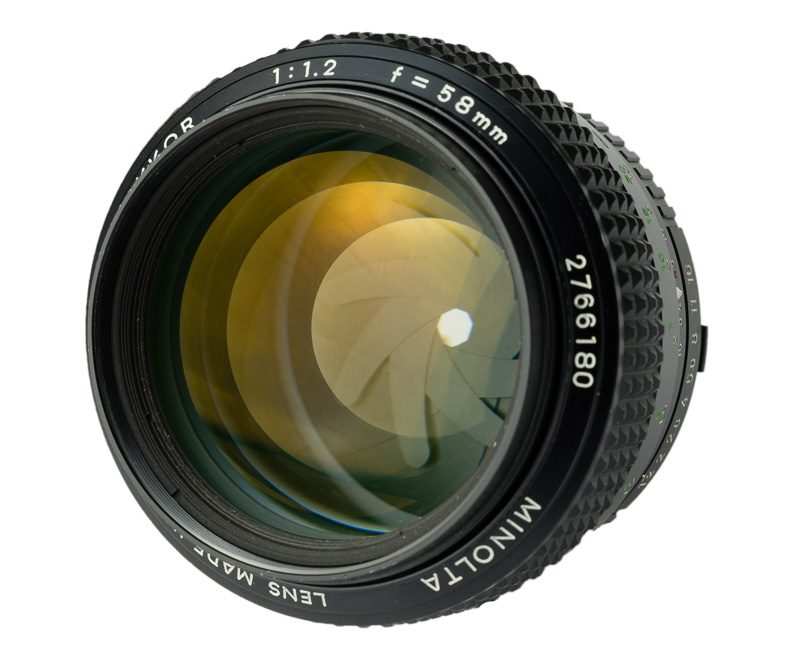
The Minolta MC 1.2/58 is probably Minolta’s most famous lens and a personal favorite of mine. In this in-depth review I have a close look at the Minolta’s qualities and also at its weaknesses.
Image Samples
You can find most images shown in the review in full resolution in this Minolta MC 1.2/58 flickr album.
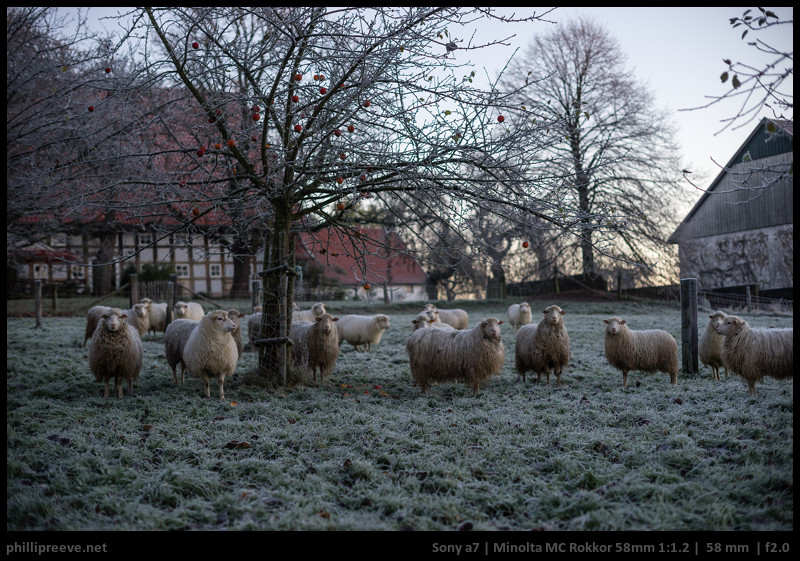
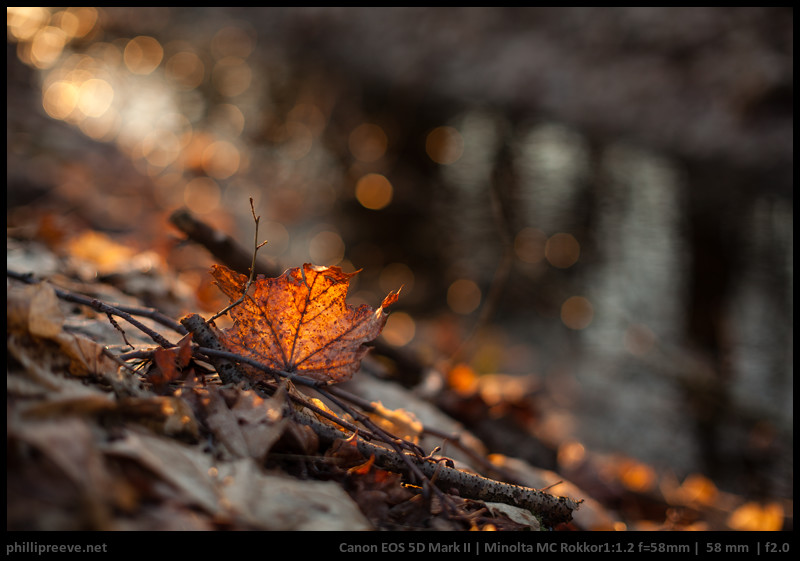
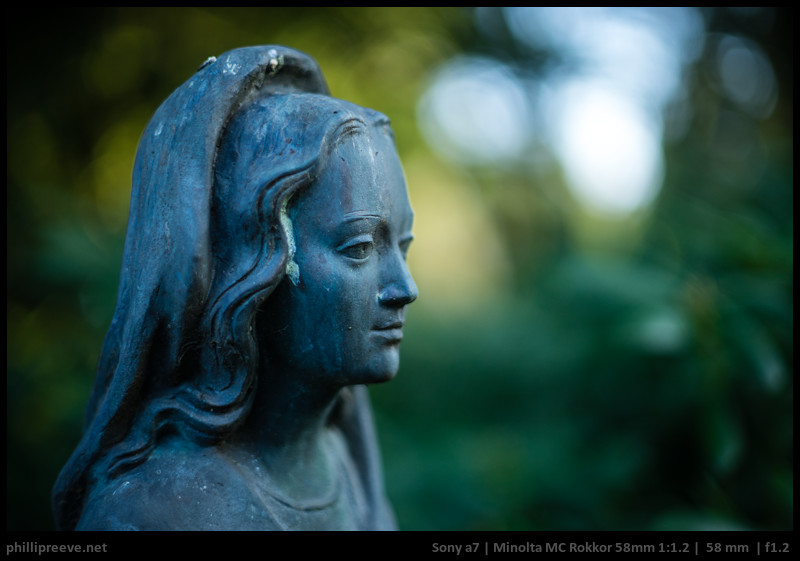
Contents
Specifications
| Diameter | 71 mm |
| Length | 54 mm |
| Filter Thread | 55 mm |
| Weight | 478 g |
| Max. Magnification | 1:8 |
| Close Focusing Distance from the sensor | 0.6 m |
| Number of aperture blades | 8 |
| Elements/ Groups | 7/5 |
Features and Compatibility
The Minolta’s most sought after feature is its speed: many photographers pay a very significant premium for the super fast aperture of f/1.2. In my experience this aperture is actually of limited practical use and I would argue that its biggest feature is the very nice bokeh at f/2. More on that in the review.
The Minolta MC 1.2/58 is a fully manual lens. Because of the mechanical construction of the lens it is, in contrast to almost every other Minolta SR-mount lens, quite easy to adapt it to either Canon EF or Sony A-mount.
Adapters are made by Leitax and Jim Buchanan. I used the lens on a Canon 5dII for some time with a Leitax Adapter which is really solid, without modification it can’t be focused further than 5m without hitting the mirror though.
It is even easier to use this lens with a Sony a7 series camera or any other mirrorless system because these cameras have a flange focal distance than traditional DSLRs and this lens can be directly adapted with a adapter.
Also check out my Minolta SR-mount adapter guide.
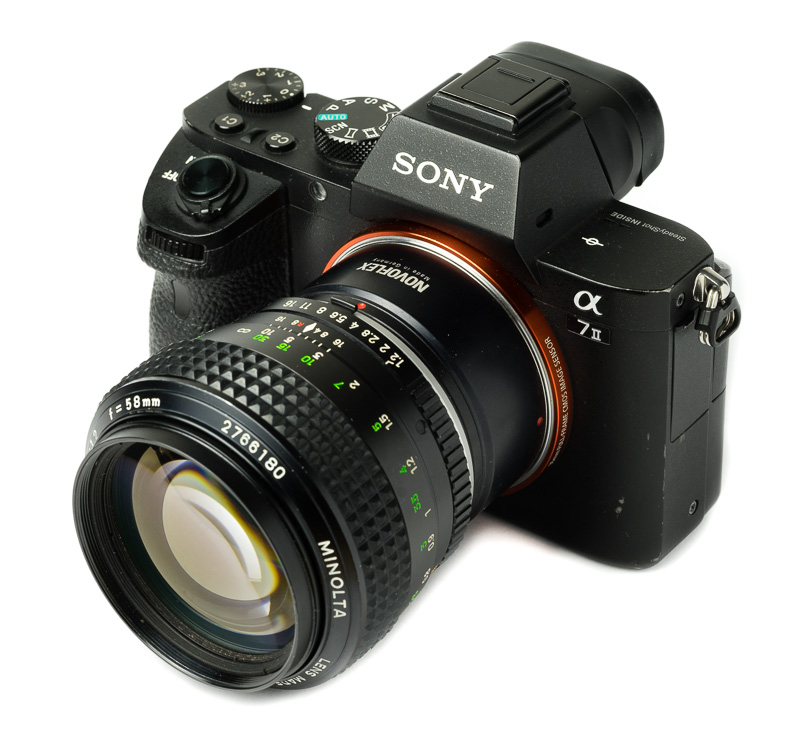
Versions
There are 3 mechanically different versions of the lens which share the same optical design.
The first version was built from 1966-1969 and the focusing ring is made completely from metal and flat. It is the rarest of the three versions and its lenses develops a yellow cast over time which might be due to a radioactive element. You can see an image of it here.
The second version was built from 1969-1973 and the focusing ring is also completely from metal but it has some elevations which the first one didn’t have.
The third version is most common and was built from 1973.
The lens has a rubberized waffle style focusing ring and while all the earlier versions were labeled Rokkor-PG (indicating a 5 Groups, 7 lenses design) the PG-affix was dropped during the production of this version.
The images shown in this post depict the third version.
All versions seem to perform the same, of course there is sample variation and someone might find that his older copy performs better than a younger one but I don’t know of any evidence indicating a systematic difference between them.
Build quality and handling
The lens is completely made of high quality metals with a rubberized focus ring. It feels very solid.
It is really resistant to mechanical wear, even though I have used this 45-years-old lens quite a lot there are close to no scratches.
The focus ring turns nice an smoothly. The focus ring travels about 80° from 60cm to 1m and a further 95° to infinity which is just about right for any application. It doesn’t get better than this.
The aperture ring can be adjusted in half-stops, only from f/1.2 to f/2 the is no stop between. The ring feels very solid and the clicks are distinctive.
The original hood is quite rare and pretty expensive. Since I don’t own it I can’t tell you much about it. I use a very solid metal hood from the MC 1.4/50 instead which is a little shorter but protects the front element well.
Size and Weight
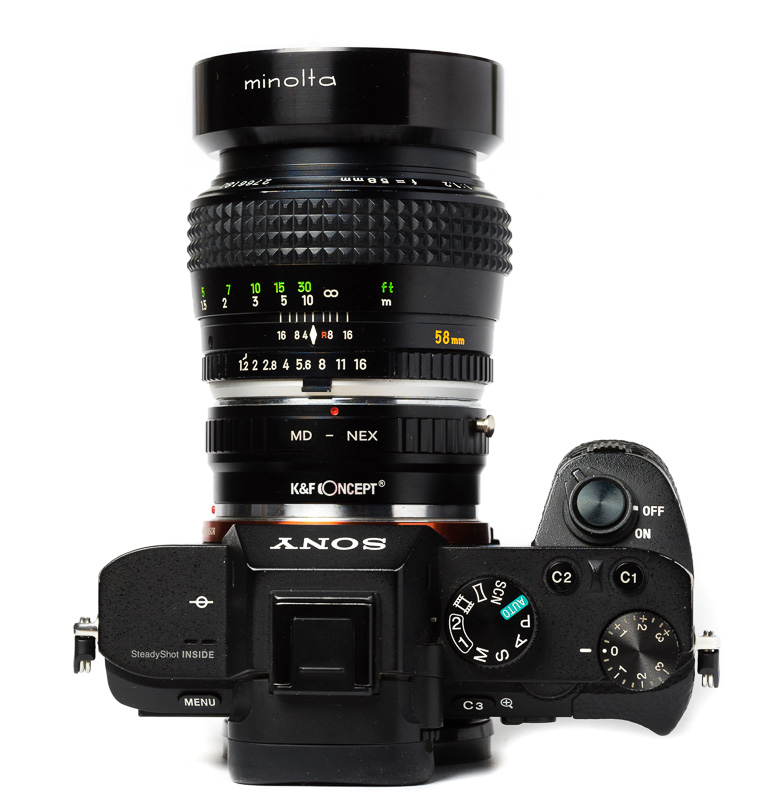
At 478g the Minolta MC 1.2/58 is a substantial lens and significantly heavier than other f/1.4 standard lenses which are usually below 300g. So it is a little annoying to carry it but handling is about perfect on my a7II where it is very well balanced.
Optical performance
These results are based on the use with a Sony a7 and a7II.
Flare Resistance
Minolta lenses are known to be rather flare prone and the 1.2/58 has a pretty big front element so it is hardly surprising that it often shows ghosting and veiling flare. If good flare resistance is important to you, this lens is not for you.
At times I like to embrace this technical weakness and play with it.
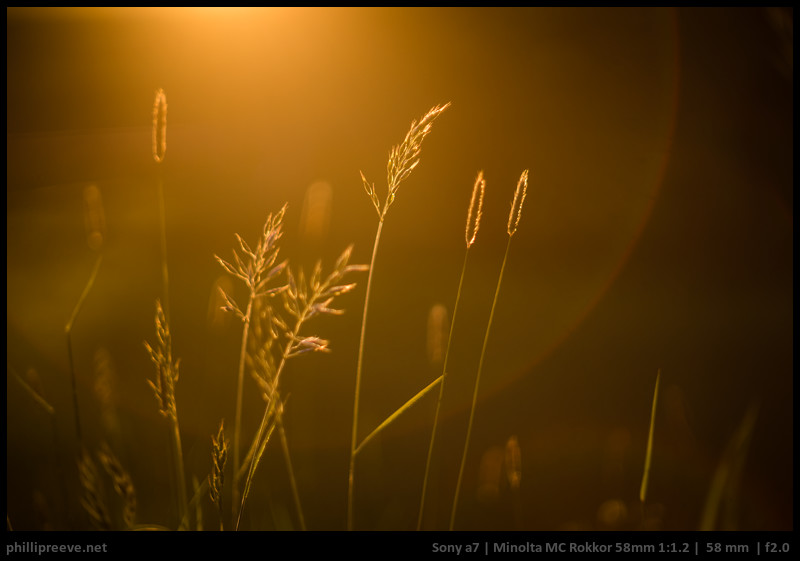
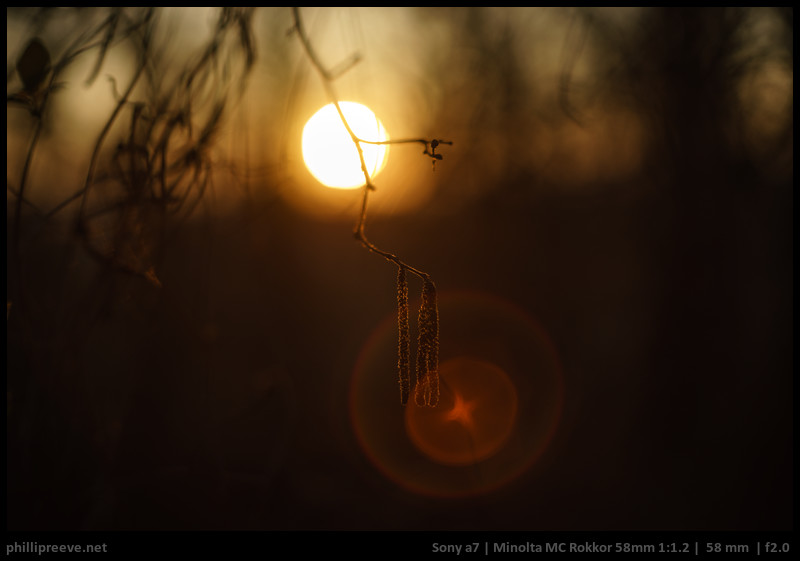
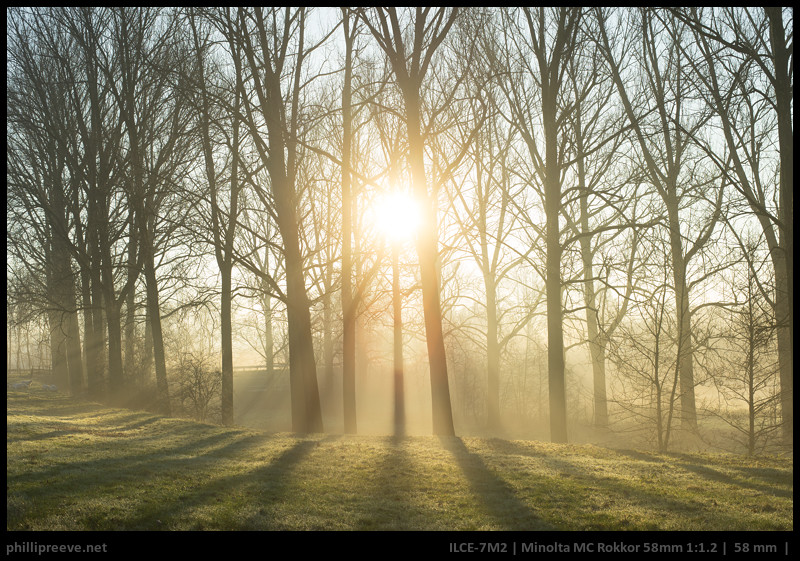
Sunstars
The Minolta is one of few SR-mount lenses with 8 aperture blades which results in somewhat decent sunstars stopped down to f/11 or f/16 but you have to consider the bad flare resistance so this isn’t worth that much.
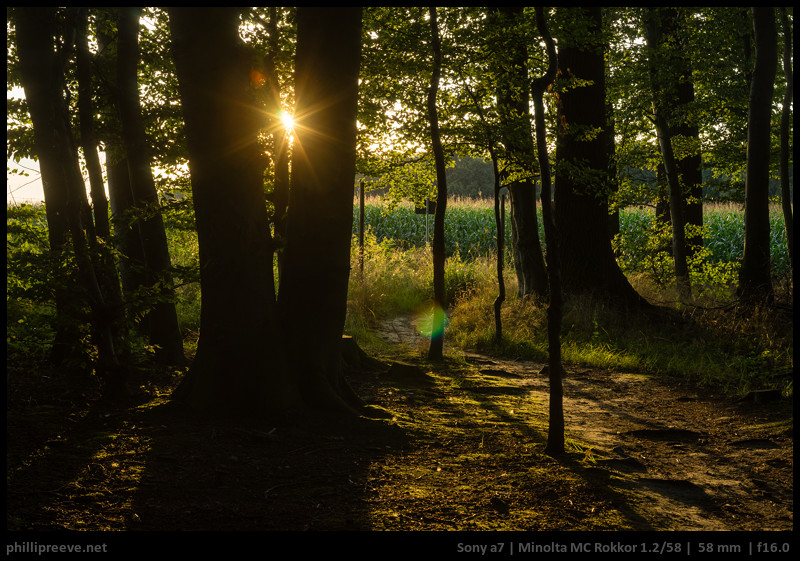
Bokeh
The Minolta MC 1.2/58 has a reputation for its bokeh so let’s have a in-depth look at it.
Scenario 1: Medium Distance
- At f/1.2 bokeh is somewhat busy. There is quite a bit of outlining in bright oof highlights behind the focus plane as well as quite a lot of green fringing.
- At f/2 bokeh is smooth with hardly any outlining and much less fringing.
- f/2.8 is even smoother but of course with significantly less blur. The aperture shape doesn’t really deteriorate.
The transition zone is rather smooth at all apertures.
Scenario 2: Short Distance, backlit
Here the busy bokeh wide open is less distracting and color fringing not an issue because of the warmer colors.
Scene 3: Medium Distance, backlit.
This is a torture test which would be a hard test for any lens. Even at f/2 which gave very good results in the tests before the Minolta struggles. As before the center shows somewhat busy bokeh wide open which improves a lot at f/2 so no real issues here. The issues are visible at the edges which are pretty busy. Stopping down to f/2.8 reduces the issue but it does not eliminate it. We also see quite a lot of color fringing behind the focus plane at f/1.2 and f/2. Only by f/2.8 fringing is controlled well enough.
Scene 4: Cat-Eyes and Aperture Shape
We see pronounced cat-eyes wide open and less defined octagons stopped down.
Conclusion Bokeh: So what to make of these results? Compared to any other legacy normal lens I have ever tested the Minolta has the smoothest bokeh. So the hype is justified to a degree. A few of the finest modern lenses have smother bokeh with less CA though even if that comes at the cost of onion rings which the Minolta doesn’t have.
F/1.2 field use
F/1.2 can work well for some scenarios but it should really only be used with consideration since results easily turn rather funky when scenes have a higher contrast.
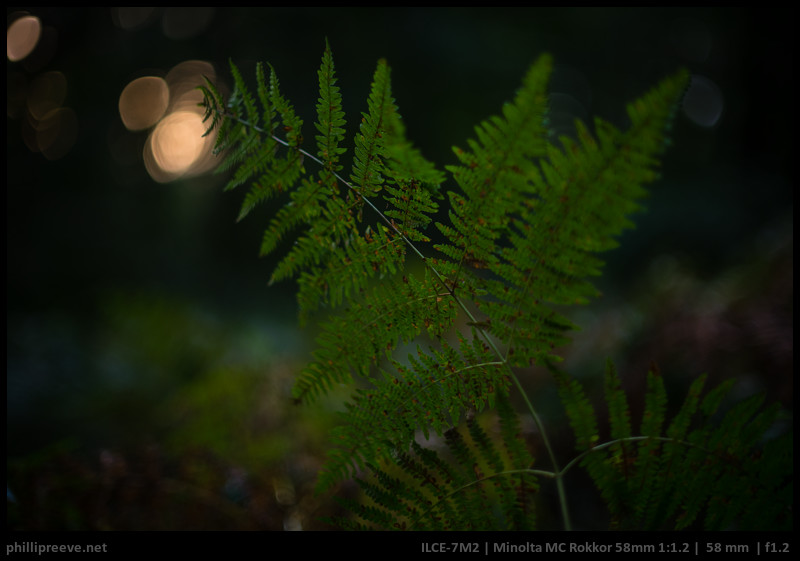
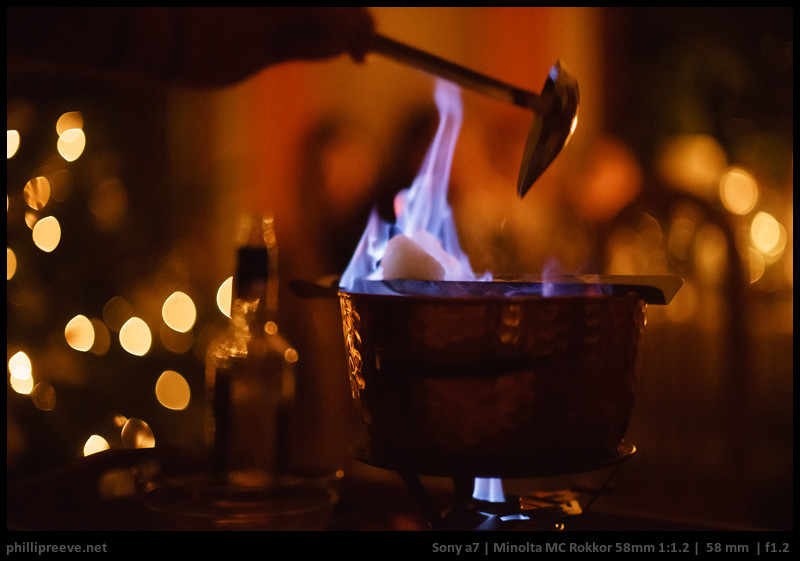
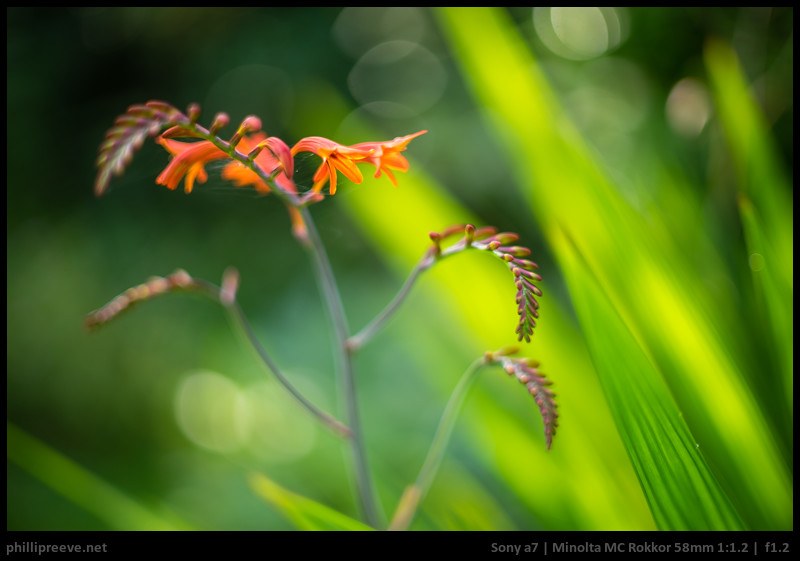
f/2 field use
Maybe 80% of the time I use the Minolta MC 1.2/58 at f/2 because at this aperture it combines decent sharpness with very nice bokeh and good blur potential.
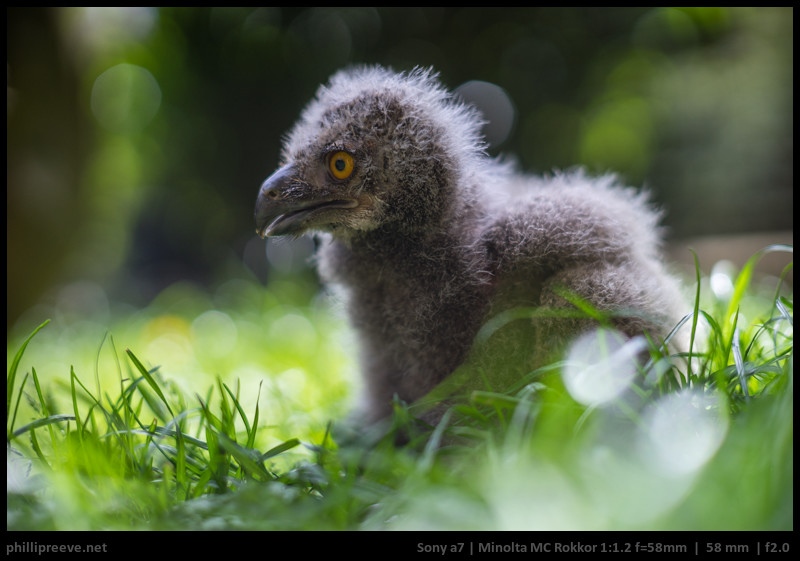
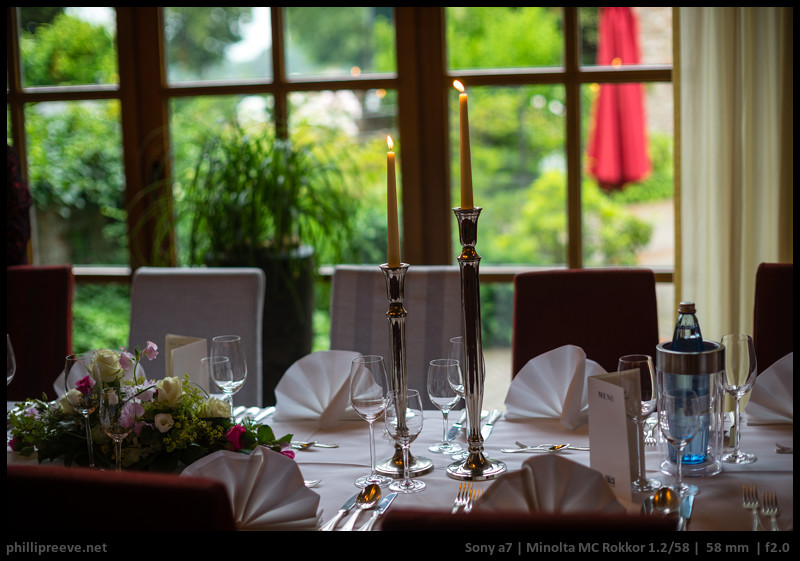
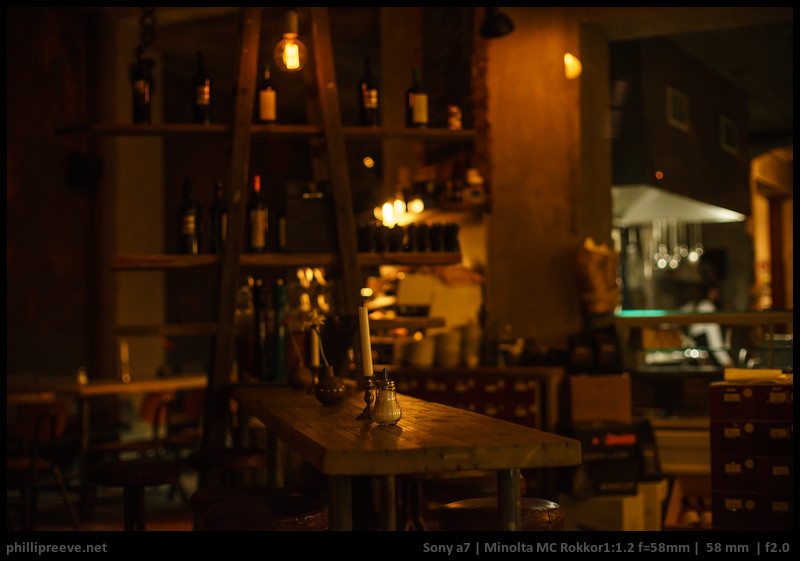
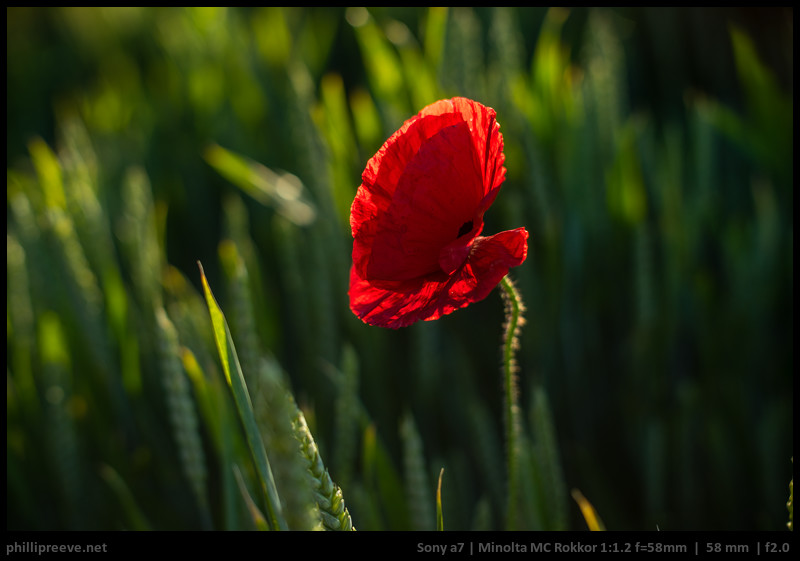
f/2.8 and above field use
I see no reason to buy the Minolta if your focus is on using it stopped down since other smaller and more affordable lenses give excellent results as well but if you have it with you you can be sure to get excellent results unless you have detail in the extreme corners at f/2.8 or shoot into the sun.
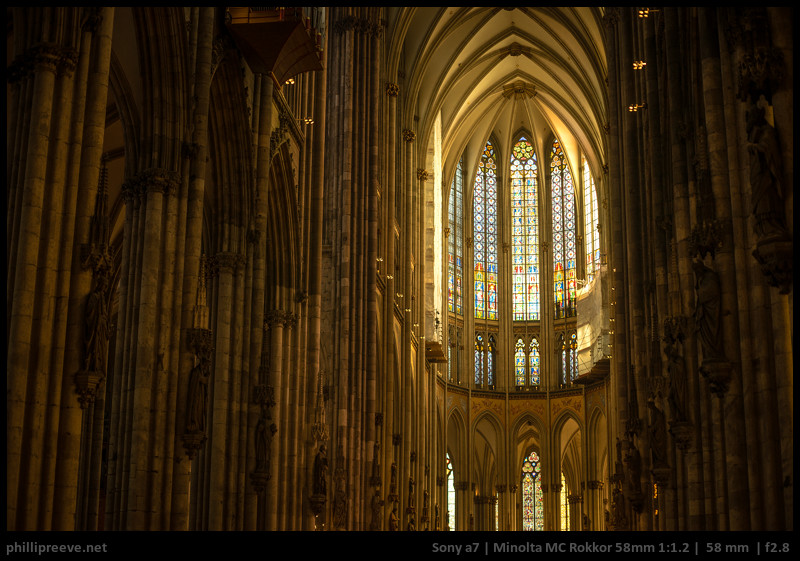
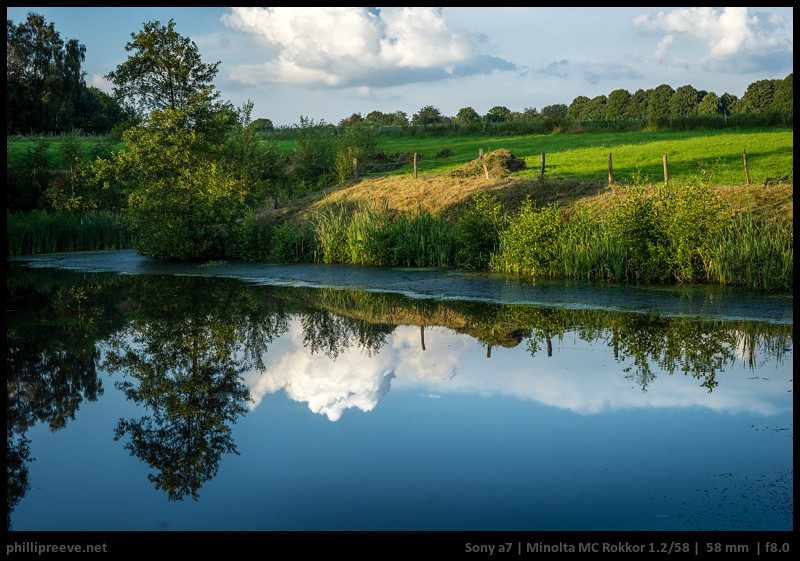
Contrast
The Minolta 1.2/58 has very low contrast wide open which improves to decent levels at f/2 and good levels by f/2.8. Sample images developed with default settings in LR.
Chromatic Aberrations
Because of the season I couldn’t find any water fountains but even so I can tell you that axial CA are an issue for some scenes at f/1.2 and f/2. CA isn’t gone completely but much reduced by f/2.8.
Lateral CA on the other hand are corrected really well and close to invisible in my testing.
Vignetting
- f/1.2: is very strong at 2.5 stops.
- f/2: is 1.5 stops which is still visible for many scenarios
- f/2.8: 0.8 stops which is hardly noticeable
- f/5.6: No issue at all at 0.3 stops.
From my testing I also have to report that transmission in the center is improved by just one, not the expected 1.5 stops in the center.

Distortion
The Minolta 1.2/58 shows minor barrel distortion which should be hardly noticeable but it can be corrected almost perfectly with a setting of +4 in LR.
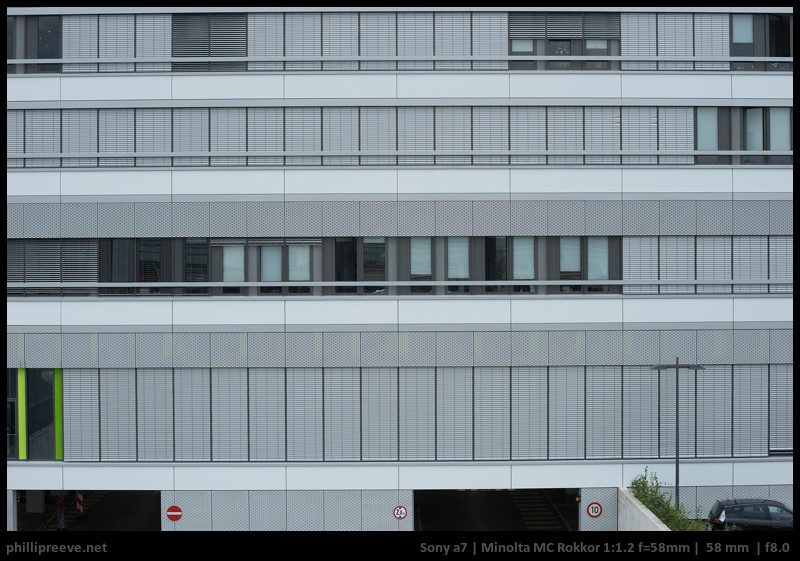
Sharpness

f/1.2: We see lots of spherical aberration which reduces contrast a lot so the sharpness impression is low. Resolution is actually quite good across most of the frame. Only the last quarter shows bad resolution.
f/2: Now most but not all of the SA is gone and the sharpness impression has improved a lot. Most of the frame is sharp to very sharp, only the last quarter of the image circle shows low sharpness.
f/2.8: By now all SA is gone and the Minolta 1.2/58 shows excellent sharpness across most of the frame. Compared to f/2 the improvements are most obvious off center. The sharp area increases quite a bit but the corners remain soft.
f/4: A minor improvement in the center and midframe area but the very sharp area extends further and stops just before the extreme corners.
f/5.6: A small improvement in the corners which are very good by now.
f/8: A slight decrease of center sharpness but a slight increase of corners sharpness.
f/11: The whole image is a little softer.
Alternatives
Minolta MC 1.7/55: The lens which comes closest to the 1.2/58’s qualities while remaining very affordable. Bokeh isn’t quite as nice but close. The much smaller and lighter 1.7/55 is a little less sharp and doesn’t resolve as well at f/1.7 as the 1.2/58 at f/1.2 but it is usually sharp enough. Another advantage of the many times as expensive Minolta 1.2/58 is that it has 8, not just 6 aperture blades which matters stopped down to f/2.8 or more.
230g | $15-35 | ebay.com (affiliate link)
Mitakon 0.95/50: Significantly heavier and more expensive but if you want a super fast normal lens with good performance from wide open the Mitakon is the better lens.
780g | $799
Voigtlander 2/65 APO: This is technically one of the very best lenses you can buy today. It is exceptionally well corrected for any aberrations and excellent across the frame from wide open. It is a little bigger and a little more than twice as expensive as the Minolta.
635g | $999 | amazon.com (affiliate link)
The Sony FE 1.8/55 costs two to three times as much and it is sharp to the corners from f/1.8 with very smooth bokeh. Bokeh is also exceptionally smooth but occasionally spiced with some onion rings. Built quality is not as good as that of 1.2/58 and the manual focusing experience is certainly inferior.
281g | about $700 used | at ebay.com (affiliate link)
The Canon nFD 1.4/50 is a little sharper and much lighter and affordable but I don’t like the bokeh as much and built quality is inferior as well.
235g | about $50 used | at ebay.com (affiliate link)
Conclusion
pros
|
average
|
cons
|
If you look at the table above you see a longer list of cons than pros. This design is 50 years old and it shows. And yet remaking this review gave me a reason to use the Minolta 1.2/58 again and I enjoyed the experience quite a lot so I think that I will use it more often in the future. I can’t quite rationalize why I enjoy this lens so much when I own modern technically much better lenses like the CV 2/65 APO but I do. If you aren’t on a tight budget and want to experiment with legacy lenses then the Minolta MC 1.2/58 would be one of my first recommendations. You will be hard pressed to find a lens with better build quality and I don’t know a legacy normal lens with more pleasant rendering .
In practice f/1.2 isn’t of that much use unless you enjoy funky bokeh and very low contrast. You gain quite a bit less exposure than the theoretical half stop over an f/1.4 lens and you have to live with very strong vignetting of 2.5 stops. Wide open the Minolta can give decent results in rather dark scenes where you can count on having good resolution across most of the frame.
At f/2 the Minolta shines brightest for me: In most scenarios you can enjoy very smooth bokeh combined with good sharpness. It doesn’t have quite the same micro-contrast as the best modern lenses and CA can be an issue but for most scenes I like the results a lot.
Stopped down to f/2.8 the Minolta makes very good use of a 24 MP FF sensor. About 80% of the frame shows excellent sharpness, competitive with good modern lenses. For very good corners you need to stop it down to f/5.6 or f/8 but then you won’t see a difference between it and more expensive modern lenses apart from the weak flare resistance.
The Minolta MC Rokkor 1:1.2 58mm isn’t the most reasonable purchase: It starts to shine only from f/2 and for a 2/58 it is bloody expensive and heavy. Despite this and a few other deficits the Minolta is one of my all time favorite lenses. After all the testing I did for this review I can’t really explain why. This is a bit frustrating but maybe my images do a better job of explaining my sentiment.
The Minolta MC 1.2/58 sells for $350-450 at ebay.com or 330-400€ at ebay.de (affiliate links). Also check out my Minolta SR-mount adapter guide.
If this review was helpful to you, please consider using one of my affiliate links. Thanks ?
More Image Samples
You can find these more images in full resolution in this flickr set: Minolta MC 1.2/58.
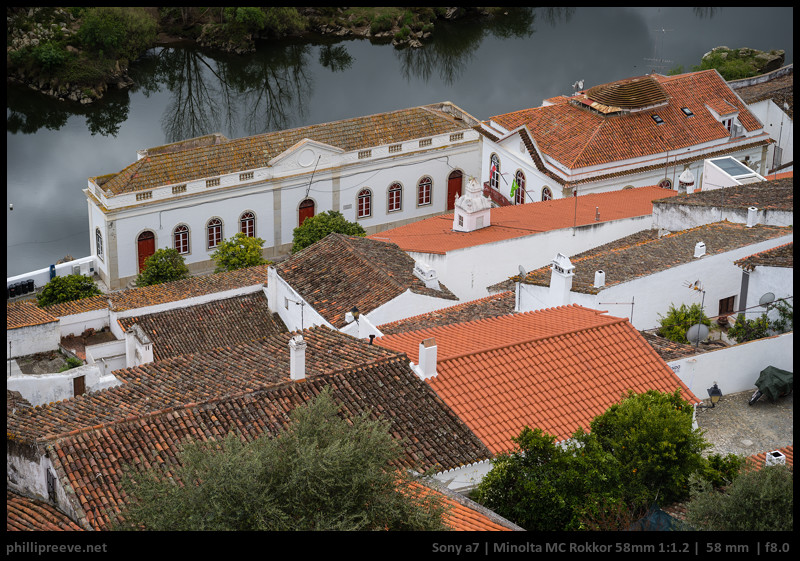
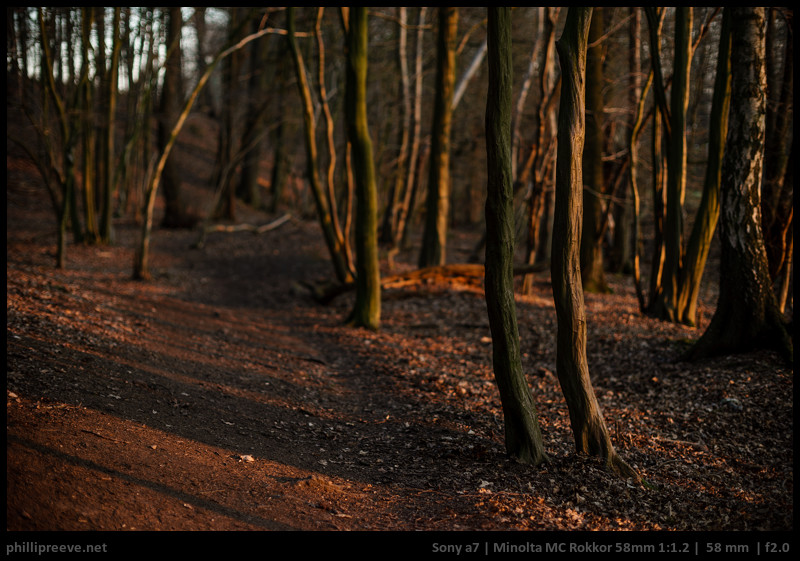


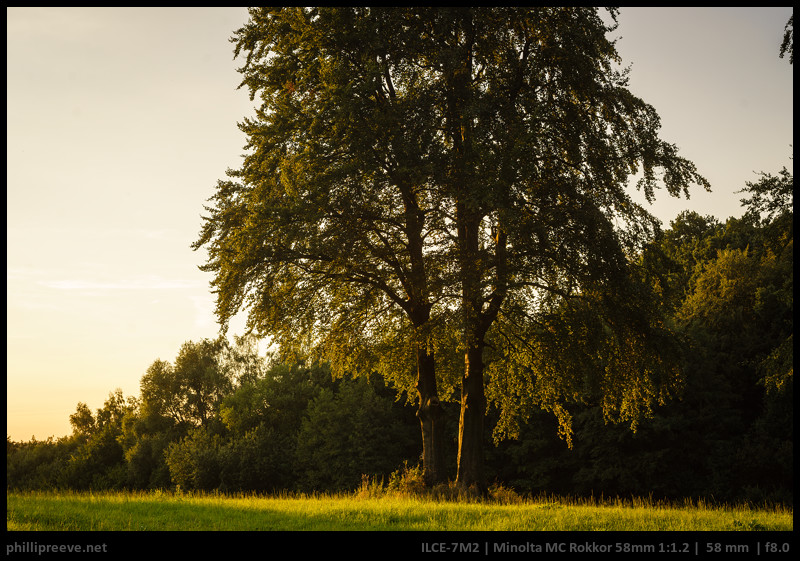



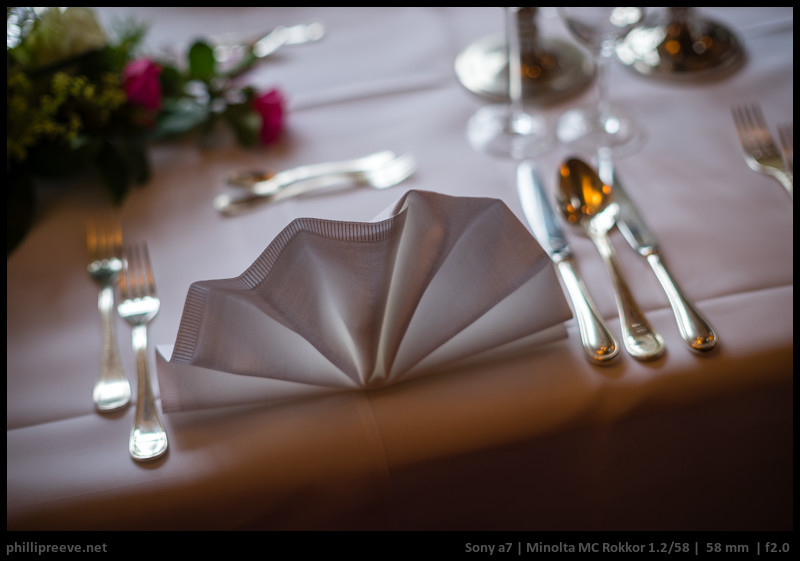
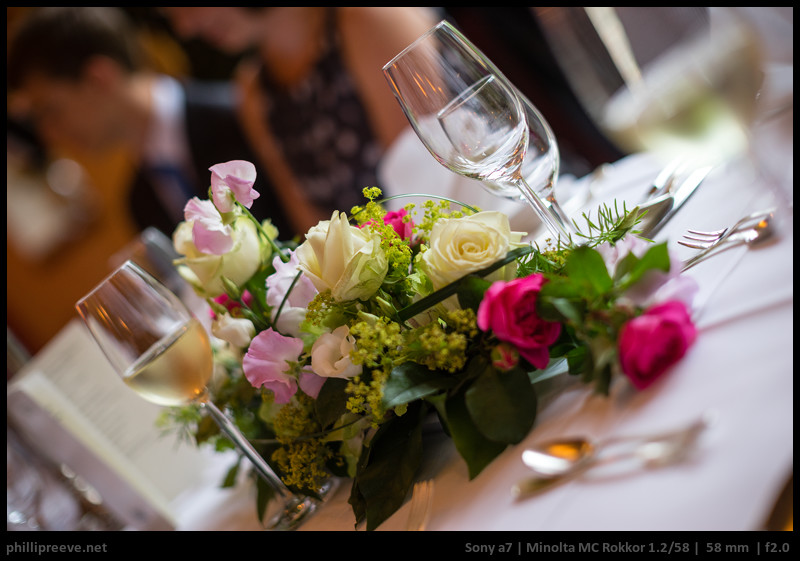
You can find these more images in full resolution in this flickr set: Minolta MC 1.2/58.
Other articles
- The Best Lenses below $499 for the Sony a7 Series
- Beginner’s Guide to Manual Lenses on the Sony a7
- Sony FE lenses: A comprehensive and independent guide
- The Guide to Adapters for Minolta MC and MD lenses
This site contains affiliate links. If you make a purchase using any of the links marked as affiliate links, I may receive a small commission at no additional cost to you. This helps support the creation of future content.
Latest posts by Phillip Reeve (see all)
- Review: Samyang AF 75/1.8 FE - April 12, 2021
- The FE-List now has 113 lenses on it - March 25, 2021
- 2020 – Year’s end review - December 28, 2020











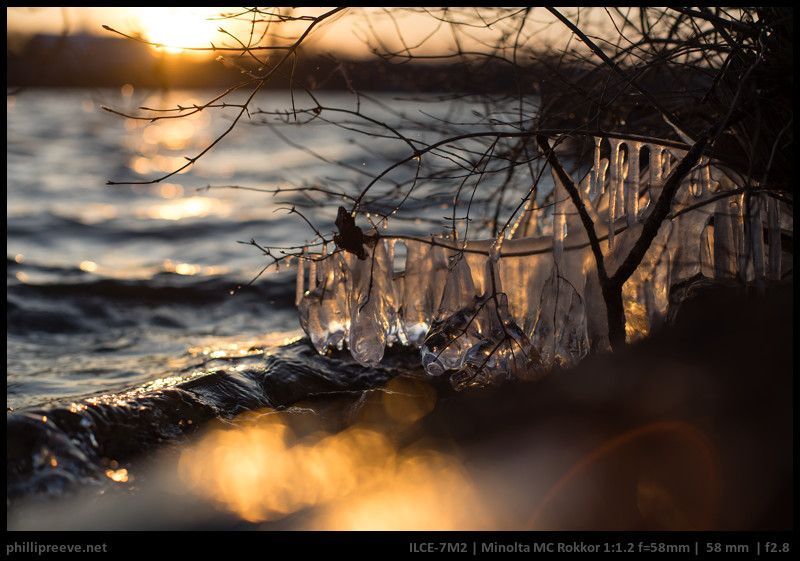

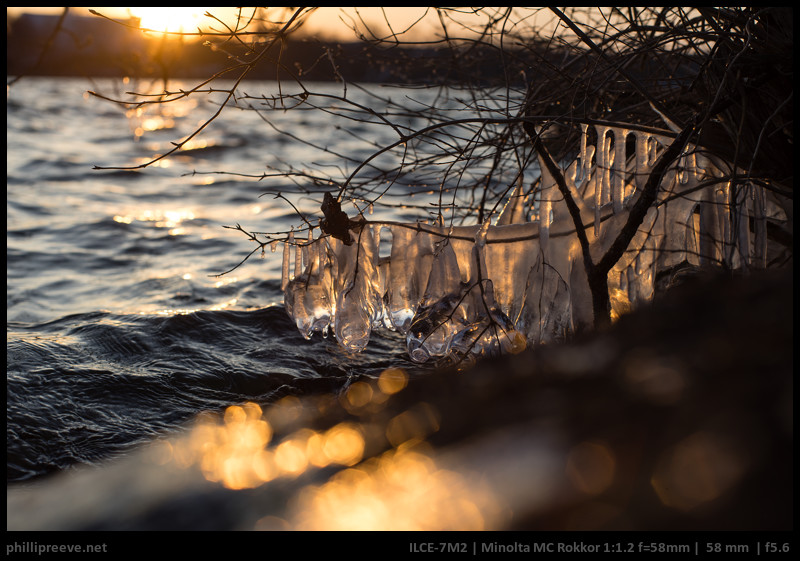






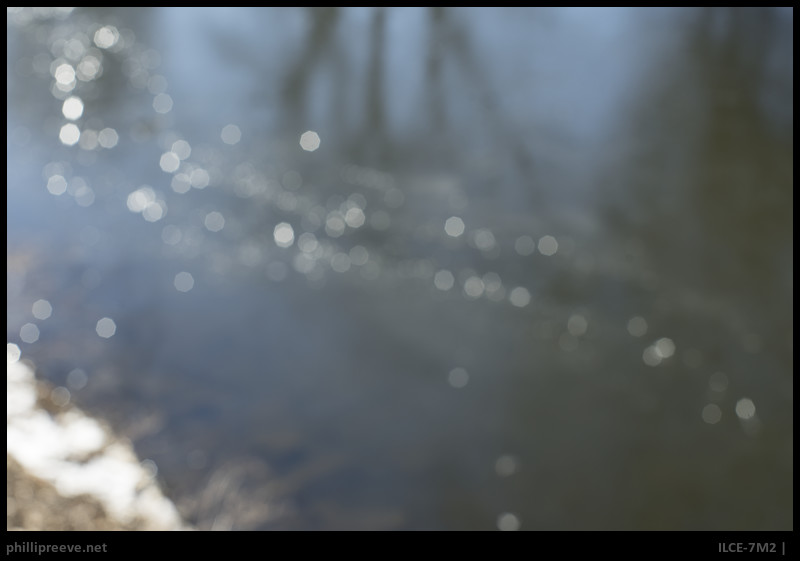



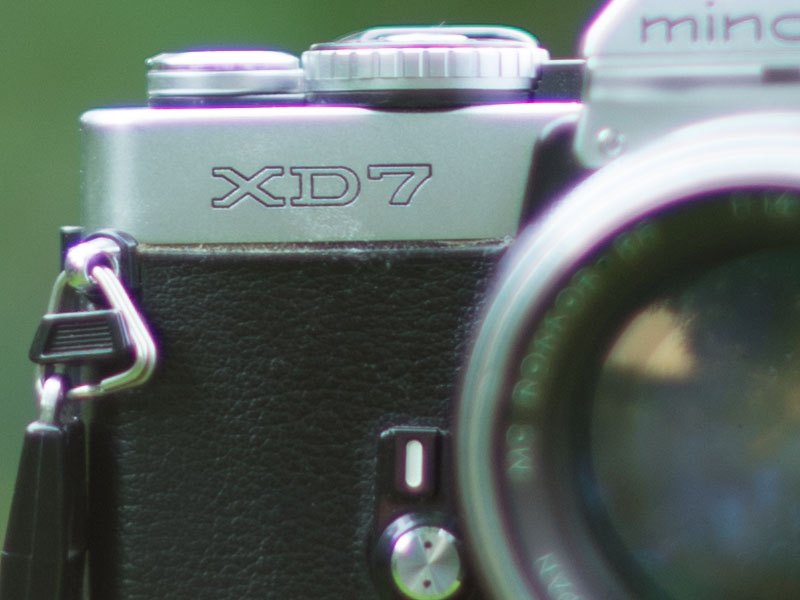

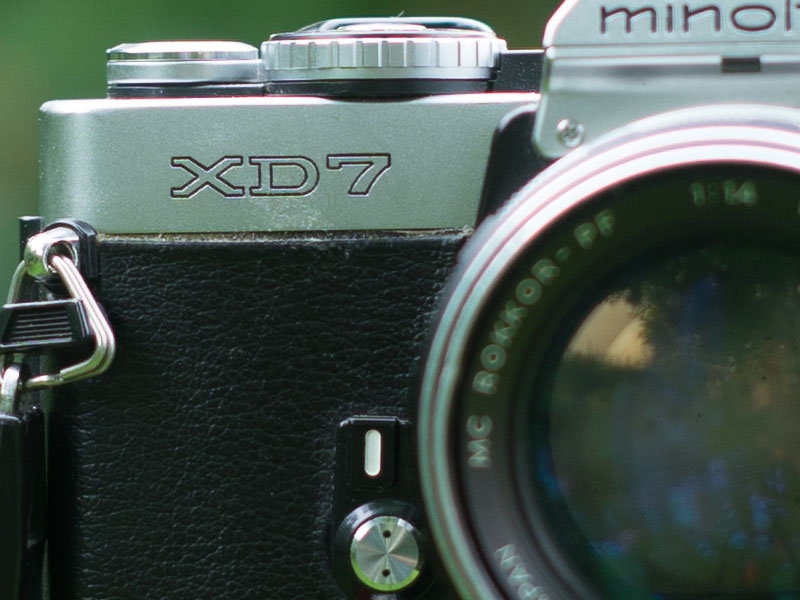
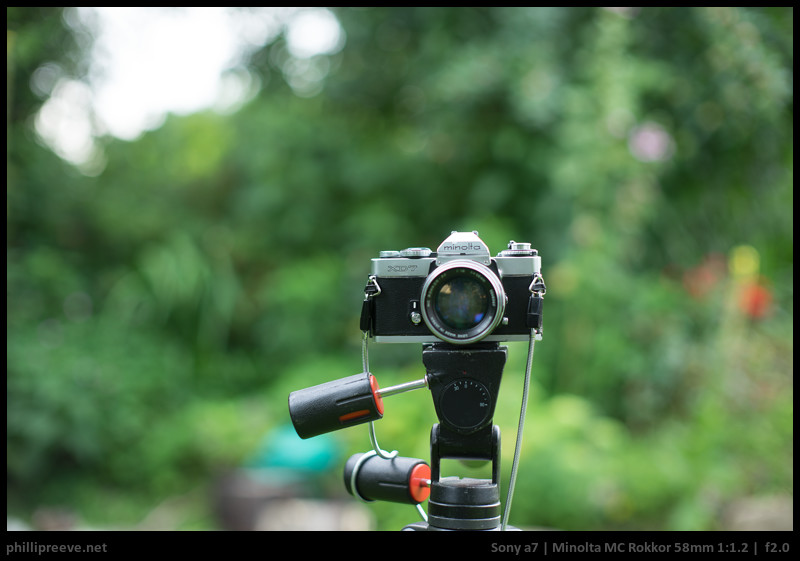
Hi Phillipe,
Seems there were 4 versions of this gem.
I’ve a Rokkor PG with the rubborized waffle style focusing ring, and by reading the link you mention for the 2nd version, there is a range of serial numbers not referenced starting with 260xxxx (mine is part of the range).
Though it was worth to mention it to you.
Congrats for your site and the interesting articles 😉
Ricardo
thanks,
to be honest I mostly use Canon FD glass now, the 1.2/58 and the 35-70/3.5 are the only ones which I use quite regular.
Phillip
It’s 2021. With all these years elapsed, which are you liking more now, the Canon FD or the Minolta Rokkor? (58mm f/1.2)
I have kept the Minolta but use it rarely these days. Unlike my Voigtlander 1.2/40 ;).
Great read and has made me buy one of these beautiful lens!
I’m looking forward to trying it on the A7R.
Are there any other Rokkor lenses that you would recommend for your A7?
Really enjoying your site and comments 🙂
Hey Peter
I have a Minolta 58 f1.4-one of the best ever-a MC 200 f4-nothing sharper, MC, MD rokkor 24-again nothing sharper-a 55 f1.7 and a 50 f1.7-again super sharp-the 200 and thd 24 were in conjunction with Leica. The 50 mc rokkor macro and 100 macros are outstanding-also the 85mm f2 version is awesome.
Hope this helps
best
Greg
Does autofocus work with this lens?
no
Great review Phillip with some really nice images. This is one of the most exciting lenses I’ve used and the only thing that has a similar image rendering is the new Nikon 58 1.4g which costs much more and has a lesser build quality.
I am using it with on NEX (since it can’t be adapted for Nikon) and can’t wait to use it on the A7r 🙂
Hi,
How do you find the Canon FD 58mm F1.2 to this Rokkor 58mm F1.2?
no Idea, never tested it
Hi Philipp,
thanks for all your nice informative work. I like to follow you all over the place (forums, flickr). Maybe I can contribute a little to the last question.
I have a MD 1.2/58 and a FD 55/1.2 SSC. Both have beautiful bokeh, no question. Both are lenses to be used wide open. From my experience the Canon has much less contrast, but is much sharper, especially in the corners.
I love to use them both. If you prefer less contrast and less saturated colors like in high key portraits, you might prefer the Canon. The others probably favour the Minolta lens.
The Canon renders highlights close to the corners differently. The Minolta renders almond shaped highlights the Canon’s highlights look more like a 3/4 moon: round on the outside more flat on the inside.
Hope that helps.
thanks for your information, it is appreciated 😉
But May 2014 in this thread you wrote that you use this lens now?
the Canon? I don’t think so. I still own and occasionally use the Minolta 1.2/58
Hi!
Lens seems really nice, how close can it focus?
60cm
Nice review though I always struggle at buying fast lenses to use stopped down. I know why and I understand it, but my brain always catches on the idea.
I recently picked up the Konica 57mm f1.4 and have fallen in love with it. I also use a Nikon 40mm f2.8 which is just crazy sharp.
thanks 🙂
yeah, you pay a lot of money and carry a lot of weight for that f/1.2. But since it is the nicest Normal lens at f/2 I know of thats a price I am willing to pay 😉
I love the rendering this lens gives, it’s often “painterly”, even stopped down, (which is a very subjective term I know). However, I got so fed up forgetting to rack back from ∞ , resulting in mirror hits with the 5DII, that I sought out something else with similar rendering. The Voigtlander 58/1.4 SLII I found to be very close.
Now I use the A7 like you, I need to compare these two lenses directly. They are both beauties.
(Love your first F2 pic of autumn leaf. Beautiful light.)
Likewise, I own the Minolta 58mm f1.2 and I also have been wondering how the Voigtlander 58mm Nokton compared. Have you had a chance to make that comparison?
Nope and won’t get it anytime soon. I would expect better flare resistance and higher contrast from teh Voigtlander. No idea how bokeh compares.
Somebody totally stole your photos to put in an eBay listing of this lens. Pretty sneaky.
ebay.com.au/itm/Legendary-Minolta-MC-Rokkor-PG-58mm-f1-2-Lens-The-Creamiest-Bokeh-You-can-Get-/221653441184
thanks for the report!
Hi Phillip,
So if you’re shooting in F2 on this lens why wouldn’t you just get the cheaper F1.4 version and use that lens in F2.
I didn’t say that I never use f/1.2 ;-).
Also I think that the 1.2 is a better performer and it has 8 not just 6 aperture blades. I own a 1.4/58 maybe I will find the time to compare them a bit more carefully to be sure about my opinion.
Hi again, clearly I am late to the Rokkor world. Did you ever do a comparison with the 58mm f/1.4? I thought the question was a good one. If one prefers sharpness, might the f/1.4 version not be more economical?
My comparisons weren‘t very thorough bit my overall impression was that the 1.4/58 does not render quite as smooth and also is less sharp than the 1.2. If you want a similar lookmon a budget my recommendation is usually the 1.7/55.
Thanks for this review with good image samples. Since this lens is so much better at f2 than at f1.2, I just want to suggest another very good Minolta standard lens: the very cheap and infamous MD 50mm f2. I didn’t compare it with the 58mm f1.2 personally, but it seems to beat all the other Minolta standard lenses at f2 and f2.8 concerning sharpness. It is fully usable wide open so in case one wants to save some money and weight, it is an excellent alternative. The used price is about 5% of what the 58mm sells for, can you imagine?
I have reviewed that Minolta MD 2/50 and it is indeed the best Minolta normal lens when it comes to across the frame sharpness. But it doesn’t have the nice bokeh of the 1.2/58 nor is it build as well.
It was your test that made me use the MD 50mm f2…haha. Just forgot where I read about it, but there are more websites that mention the f2.
I just think the 58mm isn’t worth around $ 450, paying that much doesn’t guarantee making better photos, but sure there is a difference in quality of bokeh and build quality. What I like about the 58mm -although not owning that lens- is that it seems usable and sharp enough at 1.2. Wonder if it makes sense to go for these beasts though on a digital body. Film grain is not a problem anymore so anything that gives similar bokeh at f2 will do.
the 1.2/58 is not a very rational lens to own but one of my favourites non the less
Hi phillip!, I recently own one and came with full aperture always (aperture ring move but the blades don’t ) may be send it to clean or repair (do you have experience with similar problem?) , meanwhile I use it and always 1.2 ,do you have a profile to use on Lightroom?
Thank you very much
can’t get the aperture to close? Sticky apertures are not that uncommon and a good repair shop should be able to fix it
Hi Phillip! Appreciate your review a lot.
I just recently got a copy of this Minolta 58 mm f/1.2, and I noticed pretty severe spherical aberration wide open. As I try to focus, it achieves best contrast, but is out of focus, and when it is on focus, there is some haze-like thing. I also notice some focus shift.
Just want to confirm, it is also the case for your copy? Thank you a lot.
Thats in line with my observations. This was one of my first reviews and I wasn’t really experienced at doing them so some aspects aren’t covered.
Hi Phillip and everyone,
I have a 58mm f/1.2 in the MC Rokkor PG version. I just have learnt the good repute of this lens by your words.
Actually I thought it was not such good lens cause pictures i shot with it was not very sharp. On some of them, when i shot at full aperture, there is even sort of a lighting halo around the lit areas. I don’t have the same results as your photographies with mine, it seems to be another lens…
Maybe the photos you show are postproceed on sharpness ?
The lens have a bit of play between its pieces, do you think the problem can come from that ?
As I write: At f/1.2 it isn’t very sharp and my copy will produce halos as well. There should be no play.
Hello and thank you for putting all the info together. Have been following your blogs and have finally bought the legacy lens blog. I recently purchased the 50mm 1.2 and am also looking at 58mm 1.2 just to play around.
What I am keen to know is whether a7ii is better to use with these lens and adapters or a7rii? I am in the market for one and with the recent trade-in promo, both are within reach. Is there any damage to the camera by using these (I suspect not but just to be absolutely sure.) Appreciate your guidance.
The camera doesn’t really matter, results with the a7rII wil bet at least as good as with the a7II often better.
Hey, I was wondering if this lens was compatible with Minolta X300.
I just discovered your website and I have to say I already love it.
Cheers
It is
Great review Phillip!
I’m using the 58mm MC Rokkor-PG 1.2 on an A6000. Shooting wide open I’m experiencing same banding issues as described here: http://admiringlight.com/blog/first-impressions-handevision-ibelux-40mm-f0-85/ . The same thing using the Super Multi Coated Takumar 50mm 1.4 with the Zhongyi lens turbo II @ 1.4. In both cases banding disappears when stepping down the lens. Have you experienced any banding on the A7 at super fast apertures? Do you know if the A6300 or A6500 have the same problem as the A6000?
Thanks
Hi Pablo, this is the first time I read about the banding and I have never experienced it with my a7 or a7ii.
To appreciate it you must look at the image at 100%, it’s more obvious on unfocused areas. Using the Takumar 50mm 1.4 without the lens turbo there’s no banding. Only with apertures wider than 1.4.
How does this lens perform at its minimum focus distance? Have you ever tried it on extension tubes?
I bought one of these. It’s your fault. I love it, though.
😀
Great article, again…
A remark though : the link to Flickr in the beginning of the article (image samples) leads to the album called “Voigtlander 65 mm F2 Macro APO-Lanthar”…
thanks, fixed
Hi Phillip,
Great review! I purchased the Rokkor MC 55/1.7 based on your previous review and love it. I have the Mitakon 0.95 and the Canon FD 50/1.4 and Sony Zeiss 55/1.8. I just tested all 4 and viewing blind was shocked that we all preferred the rendering of the Minolta Rokkor 1.7. I can’t see any need for me for the Rokkor 1.2.
I have had the Voigtlander 40/1.2 on order for weeks. Very excited to see your opinions and images when yours arrives as well. Thanks as always. Rob
Would love to see your comparison.
They are all portraits of a friend and she is self conscious. She has asked me not to post them and I need to respect that. Maybe I could repeat the exercise with something non human.
Snazzy review and I love those early morning pics. I had the 58mm 1.4 which was surprisingly sharp 2.8 and down. This one is a little pricey so never gave it a whirl. My favorite 50’ish was the 1.7 until I bought the 50mm 3.5 macro. Just seems to get used more. I’m putting a roll through my x-370 with the 40mm 2.8 right now which size and FL wise is a nice experience.
By the way, anyone interested….there’s a flickr stream called I love my Minolta 370, x-700 and x-500. Some great inspiration in there!
I agree, it’s a nice review. Too pricey for me too and if that focus ring isn’t as smooth as specified in the ebay ad..they’re not that easy to fix, M Bernier tells.
I used the 58/1,4 too, it is sharp a couple of stops down no doubt. My favorite lately has been the MD 50/2. Yes, horrible hexagons one stop down but it is actually sharp at f/2 and has perfectly fine bokeh then.
It’s a nice experience on the XD7 which I love.
Thanks a lot for the long term review.
I love this old chaps , the way it looks and how it performs.
Who care about the sharpest lens when this one offers you softness and sharpness regarding how wide it’s opened.
I have it with me all the time with the MD35f1.8 along with a XE7 or my X570.
Happy Easter guys!
Thomas
I’m surprised that you are not mentioning the fact that these lenses are radioactive with Thorium dioxide diffused in the rear glass of the lens.. The rear glass(toward camera) emits a low level emission at or below 1 microseivert per hour, which is a low level, but radioactivity is cumulative, like mercury. With proper handling and storage, it can be managed, and it is not a large consideration, however you should make your readers aware of this risk/concern.
Can you tell me something about your source and the exact version?
Have you compared your MC Rokkor 1.2/58 to the MC Rokkor-PF 1.4/58 – at 1/10th the price? I’d like someone to compare my Olympus Zuiko 1.2/55 to your 1.2/58 some day. My money is on the Zuiko. Just sayin’ …
I have been meaning to for ages but never actually did it. My impression of the 1.4/58 wasn’t that positive though.
Fantastic review, it was a pleasure to read!
I own the Rokkor-58 since 2010 around and use it on my 7A for making movies, and yet for making pictures on film also again with my XM and my XD-7 (after a long time of not using film, but these times are special and we have a lot of thinking about this and that – and so about film either)
Greeting from Germany
Dieter
Hi Phillip!
What do you think about the Konica 57mm f1.2 in comparison to this gem? I’ve heard its “the best f1.2 ever made” and wondering if you believe that as well?
Thanks!
Whenever someone tells you sth is the best whatever something ever made you should probably stop following that guy, because no honest and trustworthy reviewer would ever make such a claim.
Granted, but how would you compare the two?
I haven’t used either let alone did a side by side comparison.
Had a look at some flickr samples of the Konica, I don’t see anything special.
I have never used it. And as Bastian I don’t see anything special about the images.
I found the following site that has a wonderful comparison of several vintage 1.2 lenses.
http://digitalvintagelens.com/2018/02/23/comparison-super-fast-50s-50mm-f1-2/
I have the Rokkor 58mm f1.2 and am searching for Hexanon and Olympus samples.
How about Minolta md 50mm f1.2, what ‘s the difference between it and 58mm
Many users have reported less smooth bokeh but I have no personal experience with it
Hey Phillip, thank you very much for the detailed review. I’m just wondering if you ever color grade you picture? Or you just process them for light/exposure adjustments.
I am trying to make videos with Minolta on a7s3 and I really like your color. Could you share your picture profile, or white balance setting for the very first sample, as well as the one in Bokeh part f1.2 scenario 1? It would be really helpful for me.
I usually don’t do anything I would describe as color grading. I wrote about my processing many years ago and I still work along those lines today: https://phillipreeve.net/blog/how-i-create-images-part-3-postprocessing/ It even includes a sceenshot of the first sample you asked for. The other one is actually developed with default settings in LR.
The 58/1.2 is not the only manual focus Minolta ~50 lens with 8 aperture blades. The 58/1.4 came in at least two versions, the earlier ‘Auto Rokkor PF’ and the later ‘MC Rokkor PF’ version. My copy of the Auto Rokkor version has 8 blades, but I have also seen ‘Auto’ copies sold that have 6. The general opinion seems to be that the two versions also differ optically with the later version being superior, but no concrete evidence exists to my knowledge.
Thanks for the correction 🙂
Hi Philip,
which Canon FD lenses do you use?
I own a Rokkor 58 1.2 but want to get something in the more wider field
Thanks!
At the moment? None 😉
But I use the Voigtländer 1.2/40 all the time.
Are you sure about the 3 types? I have read different descriptions of the 3 types elsewhere. And, in fact I have a lens that has the PG on it, yet has the rubbery waffle grip on the focus ring. This should not exist if your 3 descriptions are accurate?
I write that the PG was dropped during the production of the 3 version so the older ones like yours have it, the younger ones don‘t.
Is there a chance you do the promised comparison of the 58 1.2 vs. 58 1.4?
My personal favourite 50mm vintage lens for Sony from Minolta is the 50mm f.2.0. It is quite decent at 2, has nearly zero distortion, great colour, compact and quick to focus. It is also dirt cheap. In real world circumstances, I’d put it up against the Sony 1.8, which feels digital by comparison.
Found a minolta srT101 camera w/mc rokkor pg 58mm 1.2 w/ a 200xxxx serial # , at a garage sale !
Why do these MINOLTA ROKKOR 58mm F/1.2 lenses all seem to have fungus? Is this the result of some bad coatings or what? On eBay all of the ones I have seen over the last year have had at least some fungus. And the sellers might say Excellent+++. What do you think? The f1.4 lenses don’t.
Well, first I think the is a 70’s lens so lot of them are stored in a no ideal condition. Especially in Japan(Island country) if the person doesn’t have a dehumidifier or AC chance of your lens having fungus is very high. Second, this is their flagship lens so they no many people are able to afford it so there are more copies of the 1.4 out there atm and once the clean optic is sold out the fungus will be on eBay. That just my thoughts
Great review!
I’ve been using this lens (actually little older version) for quite some time and glad that people like it too.
Have you tried the f1.4 setting of this lens?
I know, the ring doesn’t lock there. But it’s easy process to make a new slit in the inner side of aperture ring.
In my opinion, it is the best compromise for low light photography. It just clips off the ring of bokeh, most of vignette is gone, contrast is somewhere in the middle of 1.2 to 2.0 but not too bad, edge light level is almost identical to f1.2 and the ufo shape corner bokeh becomes decent rugby shape so what not to like 🙂
Many thanks for your review, Phillip!
Your lens is the MC III version:
The MINOLTA ROKKOR classic 58 / 1.2 lens is available in several versions:
1966-1968 MC I. MINOLTA MC 58 ROKKOR PG 1.2, metal focus ring, silver aperture ring. Made with Thorium-232 glass. The metal focus ring on that one has more of a flat serrated round barrel.
1968-1972 MC II. MINOLTA MC 58 ROKKOR PG 1.2, metal focus ring, silver aperture ring. Made with Thorium-232 glass. The metal focus ring have a raised serrated barrel.
1972-1977 MC III. MINOLTA 58 ROKKOR 1.2, Rubber focus grip, black aperture control ring, non-radioactive coating.
1973-1977 MC III. MINOLTA 58 ROKKOR 1.2 X, Rubber focus grip, black aperture control ring, non-radioactive coating. ROKKOR-X was available only for some countries (mostly US). In the rest, this lens came without the ‘X’ prefix.
Only the the very early examples MC I. and MC II. are made with thorium-232 glass. The variants >SN 2571225 and later are non-radioactive.
Maybe there will be an opportunity to test the old versions. Of course, all versions have exactly the same optical structure (elements and groups). But I think the different types of glass produce different characteristics. Kind regards Oliver
The older lenses certainly have “character”. I have several of the 1.4, 1.7 and 2.0. Similar results happen with the 1.4, but I think it is sharper than the 58. I have the Sony Zeiss 55 as well. it is wonderfully sharp, light and flexible, but has a much more digital feel. One of my favourite Minolta lenses is the 35mm 2.8. Wonderfully smooth lens. Nice to see something other than palm trees and ocean in a review (if you connect the dots). Keep flying the Maple Leaf!
Hi Phillip,
Do you have any information about different coating on this lens. Mine is newer version and the flare is blue color. I like the older one more..